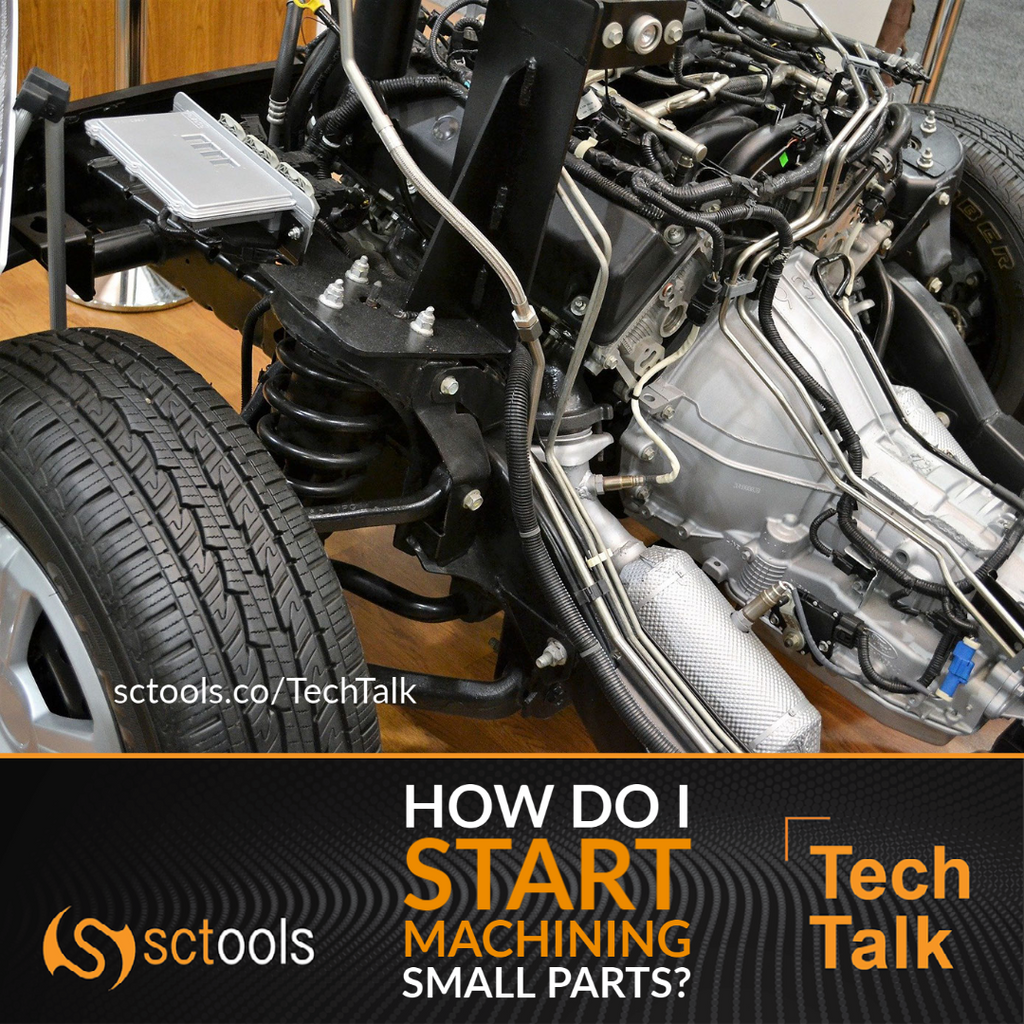.
TechTalk

How Do I Start Machining Small Parts?
Machining small parts may seem daunting for a beginner, but it is pretty easy to get started. You also have the opportunity to make a comfortable living creating a business out of machining small parts.
If you want to get started, you first need to determine the right niche for you. Are you interested in machining car parts? Do you want to machine parts for a home improvement process? Determine what parts you are most interested in making and start doing some preliminary research. Once you figure out the first project you want to tackle, you can get started by buying an inexpensive mill and experimenting with the machining process.
Start small and buy the tools you need but make sure you pay as you go instead of taking on much debt. The Bridgeport mill is one of the least expensive items you can buy when starting with machining. Getting a CNC mill does not need to happen right away if you are doing this for
a hobby, but experts recommend getting one sooner if you want to make this a business venture. Using a manual mill can take much time for machining and make it very tough to get your business going. However, if you are just in it for the hobby aspect, you should do just fine.
CAD Training
There are various places to get CAD training online, such as Autodesk, where you can get free training with self-service courses and paid training from professionals.
An authorized training center through Autodesk includes CAD Training Online, which offers self-paced training along with instructor-led training. Using Autodesk through CAD Training Online can range from $300 to $900 depending on the class and training needed if you decide to use the self-paced version.
If you go with getting an instructor with the class and training, it costs between $1600 to $2100. Other great places to learn CAD are coursera.org, skillshare.com, study.com, and udemy.com. These vary in price and topics covered. Udemy offers free courses, as well as paid courses, and are generally video lectures. Study.com is $200 a month for any courses you can finish within a month. They do not charge per class, it is a monthly fee that covers any course you want to take, and they offer CAD and Autodesk learning. All these places provide frequent discounts for their classes, so keep an eye out for those when they become available.
How to Get Started Machining Small Parts On a Budget
If you are starting with machining and are living on a budget, there are smaller milling options for you to utilize, such as a homemade pipe mill.
There may be some issues with backlash, flex, and vibration that will prevent it from being the best milling device out there, but you can still make some good things out of softer materials. Also, when it comes to writing code for them, the small machine code concepts are the same for larger mills, making the transition easier.
A smaller mill will also teach you machine design concepts which will help you know what you will need and want when you can afford to get a giant machine. The Proxxon MF70 is a decent milling machine. Some say if the Playskool brand made "my first mill," the Proxxon MF70 would be the result.
It is excellent to learn new machine concepts and only costs a couple of hundred dollars. You can use some hand tools, hardware store parts, and skateboard bearings to turn it into a CNC mill too. You can use them to work on aluminum and brass objects. They also have a decent spindle
with enough power and speed to cut metal to full-on engraving. However, the mills are small and only make small parts, but they are great for beginners with a low budget and space.
CNC Routers

CNC routers are usually used for contours and 3D shapes made from plastic, wood, or foam for various uses. Now that they are more accurate and precise, metal workers use them for machining smaller parts that previously required a CNC milling machine. The combination of large table size and the high-speed spindles makes CNC routers ideal for making smaller parts made from sheets or plates. CNC routers use a computer-controlled cutting machine mounted on a handheld router to allow for better cutting.
It is like a CNC milling machine, which uses the machining process of rotary cutters to remove materials from parts. On the other hand, CNC routers use computers and software programmed by the user to cut pieces. There are two kinds of software used: CAD for making designs, and CAM, which allows the designs to be translated into instructions for the machine in horizontal, perpendicular, and vertical coordinates.
You can also manually program, but it makes it less accessible and allows for less flexibility in contouring. The CAM software converts the CAD design into G-code for use with the CNC router.
With a CNC router, you can cut various things, such as metal, wood, stone, and polyurethane foam. There are different CNC routers for these objects as well, depending on what you want to cut will depend on what kind you will need to get.
A frequent issue with these machines has been the workholding, which vacuum workholding can help resolve.
Vacuum Workholding
Vacuum workholding uses a thin, porous material that goes between a vacuum plate and the workpiece. This process allows the vacuum pressure to hold the stock in its place while a coating will keep the parts fit together, so they stay in place even once they are cut from the plate.
Because of this, developers believe the material makes CNC routers more practical to produce small and thin parts.
An issue with vacuum workholding is that it will not let you cut small parts in one setup due to its surface area not giving enough holding power. A way around this issue is to keep the components attached to the sheet by using tabs, which requires the extra step of breaking the tabs to separate the parts while deburring the parts where the tab is attached. However, this can leave marks on the part contour, which makes the final product less professional-looking.
The other issue is that the use of tabs requires more space between parts, thus requiring more materials. This can be a significant cost issue the more extensive the project is in the end.
Sometimes marginally sized parts can be held in place by the vacuum and placed in one step without tabs, but only if a lot reduces the feed rate.
Such a step will also reduce the production rate, which can be an issue for the team. Other options for workholding on CNC routers include double-sided tape for holding small parts together securely; however it involves a cleaning step because of the adhesive from the tape.
Professionals will also use an adhesive spray. However, it creates the same issue of having to clean the parts afterward.
Another option is a new thick and porous material called Vilmill. It combines the use of a vacuum with the adhesive side of workholding. Vilmill works as a substrate between the sheet or plate and a vacuum table or chuck, held in place by a vacuum.
Such practices increase the power of workholding in two different ways. First, it provides even vacuuming over the entire surface of the table or chuck and not just the smaller holes it has.
Also, the adhesive coating is on one side and goes between the vacuum plate and the plate stock, sticky side up to hold the plate stock in place.
In this regard, the coating is less sticky than the tape or spray and only gets sticky until the milling process activates it from the cutter's heat.
When you do the milling of the part contours, it can be done in just one step if using a thin material. The thicker the plate, the more cuts it may need.
The Vilmill will get cut into by the router bit or end mill between 0.003-0.005 inches. This will keep it as one sheet because it is now holding the piece, which is also being held by the vacuum. More machine industries are using this Vilmill to machine parts, big or small.
Benefits to Using Vilmill Include the Following:
· No clamping needed.
· Parts held in place.
· Increase the production by increasing the feed rates of machines,
especially in smaller parts that are harder to hold.
· No tabs are required.
· Parts can be nested together, requiring fewer materials.
· Part contours have a better edge finish due to being only one step.
· No residue to clean up afterward.
· one can remove parts easily without warping
· Low cost.
· Environmentally friendly due to lack of dust and spray adhesive.
· It can also double as a conveyor belt to help with loading and unloading parts.

If you have any questions about carbide cutting tools, be sure to reach out to us @ sctools.co/Home or call us at (877)737-0987. We help you machine better!


Comments (0)